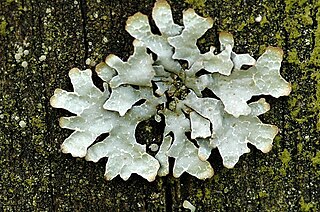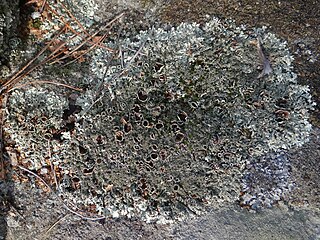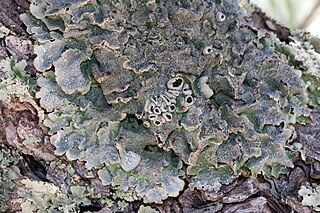
Parmelia is a genus of medium to large foliose lichens. The ends of the leaf-like lobes are often squarish-tipped. The upper surface is pale bluish-gray to light brown in direct sunlight, with a network web-like ridges and depressions. The lower surface is black and has rhizines anchoring it to the substrate.

Parmelia sulcata is a foliose lichen in the family Parmeliaceae. It is very tolerant of pollution and has a cosmopolitan distribution, making it one of the most common lichens. It harbours a unicellular Trebouxia green algal symbiont.

Myelochroa is a genus of foliose lichens in the family Parmeliaceae. They are commonly known as axil-bristle lichens. It was created in 1987 to contain species formerly placed in genus Parmelina that had a yellow-orange medulla due to the presence of secalonic acids. Characteristics of the genus include tightly attached thalli with narrow lobes, cilia on the axils, and a rhizinate black lower surface. Chemical characteristics are the production of zeorin and related triterpenoids in the medulla. Myelochroa contains about 30 species, most of which grow on bark. The genus has centres of distribution in Asia and North America.

Parmotrema is a genus of lichen belonging to the family Parmeliaceae. It is a large genus, containing an estimated 300 species, with a centre of diversity in subtropical regions of South America and the Pacific Islands.
Everniopsis is a fungal genus in the family Parmeliaceae. It consists of a single species, the bark-dwelling lichen Everniopsis trulla, which occurs in Africa and South America.

Xanthoparmelia conspersa, commonly known as the peppered rock-shield, is a foliose lichen and the type species of genus Xanthoparmelia. It is widely distributed in temperate zones, and has been recorded from Japan, Europe, Africa, North America, and South America.
Parmotrema aberrans is a species of lichen in the family Parmeliaceae. It is found in the Neotropics, from Mexico to Paraguay. The species was originally described by Edvard August Vainio in 1890 as a form of Parmelia xanthina. In 1958, Henry Nicollon des Abbayes promoted it to species level within Parmelia. Luciana Canêz and Marcelo Marcelli transferred it to Parmotrema in 2008.
Parmotrema abessinicum is a species of corticolous lichen in the family Parmeliaceae. It has been recorded from Africa, Asia, and Oceania.
Parmotrema abnuens is a species of corticolous lichen in the family Parmeliaceae. It was first introduced to science in 1885 as a species of Parmelia by William Nylander in 1885, who described the lichen from samples collected in Uruguay. Mason Hale transferred it to the genus Parmotrema in 1974. The species has also been recorded from Brazil and India.

Parmotrema mellissii is a widely distributed species of corticolous lichen in the family Parmeliaceae. It was first described by Carroll William Dodge in 1959 as a species of Parmelia. Mason Hale transferred it to the genus Parmotrema in 1974. The type collection was made in Saint Helena. Parmotrema mellissii has a pale yellowish-buff coloured thallus at least 12 cm (5 in) in diameter, comprising rounded lobes about 15 mm wide and long. It has been found in the southern U.S.A., the Neotropics from Mexico to Colombia and Brazil, Africa, Asia, Australia and Oceania.

Crespoa is a genus of five species of lichen in the family Parmeliaceae. Species in this genus are characterized by having an upper thallus surface that is wrinkled and reticulately ridged to coarsely foveolate.

Parmotrema zollingeri is a species of lichen in the family Parmeliaceae. It was originally described in 1860 as a species of Parmelia by German lichenologist Johann Adam Philipp Hepp, and named after Swiss botanist Heinrich Zollinger. Mason Hale transferred it to the genus Parmotrema in 1974.
Arctoparmelia separata, commonly known as the rippled ring lichen, is a species of foliose, ring lichen in the family Parmeliaceae with a roughly circumpolar distribution.

Parmotrema rampoddense, commonly known as the long-whiskered ruffle lichen, is a species of foliose lichen in the family Parmeliaceae. It is widely distributed in tropical regions and grows on the bark of oak and palm trees.

Xanthoparmelia lineola, commonly known as the tight rock-shield, is a foliose lichen species in the genus Xanthoparmelia. It is a common species with a temperate distribution. Found in North America and South Africa, it grows on rocks.
Bulbothrix meizospora is a species of foliose lichen in the family Parmeliaceae. It is found in Africa, Asia, and South America, where it grows on tree bark.
Punctelia negata is a little-known species of foliose lichen in the family Parmeliaceae. It is found in South America.

Punctelia hypoleucites, commonly known as the southwestern speckled shield lichen, is a species of foliose (leafy) lichen in the family Parmeliaceae. First formally described by Finnish botanist William Nylander as a species of Parmelia, it was transferred to the genus Punctelia in 1982. The lichen is found in Africa, North America, and South America, where it grows on the bark of both hardwood and coniferous trees. Its greenish-grey thallus is covered with tiny white pseudocyphellae – minute holes in the thallus surface that facilitate gas exchange. Some macroscopic features that help distinguish this species from other related members of the genus include the presence and the structure of the apothecia, the absence of asexual surface propagules, and the light brown color of the thallus undersurface. Chemically, the presence of lecanoric acid in the medulla and atranorin in the cortex help distinguish it from lookalikes.
Flavopunctelia praesignis is a species of foliose lichen in the family Parmeliaceae. It was first described as Parmelia praesignis by Finnish botanist William Nylander in 1872. In 1982, Hildur Krog transferred it to the subgenus Flavopunctelia of her newly circumscribed genus Punctelia, created to contain Parmelia species with punctate (point-like) pseudocyphellae. Mason Hale raised this subgenus to generic status a couple of years later. The lichen is colloquially known as the fruiting speckled greenshield. It is found in the southern United States, in various states of Mexico, and in South America. It has also been reported from Kenya, but that may be due to misidentification.

Punctelia borreri is a species of foliose lichen in the family Parmeliaceae. It is a common and widely distributed species, occurring in tropical, subtropical, and temperate regions of Africa, Asia, Europe, North America, Oceania, and South America. The lichen typically grows on bark of deciduous trees, and less commonly on rock. Some European countries have reported increases in the geographic range or regional frequency of the lichen in recent decades, attributed alternatively to a reduction of atmospheric sulphur dioxide levels or an increase in temperatures resulting from climate change.












